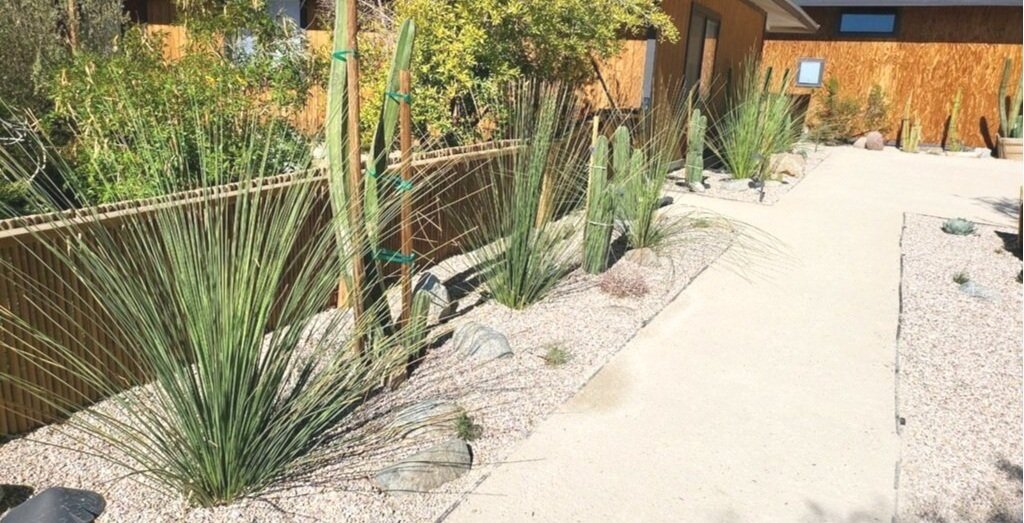Mexican Grass Tree
Mexican grass tree is becoming increasingly popular here in the Coachella Valley desert.
The unusual and striking shape of the plant works well as an architectural focal point, but it also blends nicely with other desert plants of different shapes and forms.
Finally, it tolerates drought and the brutal summers here, not to mention below-freezing temperatures.
Botanical name: Dasylirion longissimum
Other names: Sotol, Toothless sotol
Mexican grass trees planted among cacti
TABLE OF CONTENTS
Mexican grass tree Appearance
When young, a Mexican grass tree looks like a cluster of long and thin grass that shoot outwards from the center like pom poms.
The narrow, green leaves have a graceful, muted shade that complements other desert plants. These evergreen leaves can grow to 5+ feet long.
Over time, the Mexican grass tree grows a tall and vertical dark wooden trunk, bearing some resemblance to yucca trees. The trunk can grow to 15 feet tall but usually grows to around 10 feet tall. Some very mature Mexican grass trees will grow branches.
Will bloom from spring to summer. Striking white flower spike with numerous, tiny flowers. Very tall spike, often growing to over 10 feet tall when mature.
Each Mexican grass tree grows female or male flowers. The female flowers turn to a dark purple color.
Mexican grass tree Landscaping Tips
Older leaves on the Mexican grass tree will eventually become weak and droop to the ground. Many landscapers prefer to prune them for a tidier look and to discourage animals from seeking shelter amongst the old leaves.
Looks similar to Dasylirion wheeleri. However Mexican grass tree (Dasylirion longissimum) does not have such sharp edges.
Adds movement to the garden with its long, symmetrical leaves that sway in the breeze. To highlight its movement even further, add landscape lighting against a wall.
A favorite of bees when in bloom.
Very drought tolerant and tolerates a wide range of temperatures.
Performs well in containers.
Mexican grass tree works well in both formal and more laidback gardens due to its symmetry and gracefulness. They can be seen in formal courtyard gardens and clean Mid-century modern gardens as well as informal rock gardens and desert gardens.
Mexican grass tree for sale at the nursery
Mexican grass tree Origin
Mexican grass tree originates from northeastern Mexico, in areas that are mostly warm and dry throughout the year.
Mexican grass tree Care
Soil: Loose, well-draining soil that is lightly fertile.
Temperature: Can withstand temperatures down to 18 degrees for a short period of time. Does very well in heat.
Water: Occasional, deep watering. Allow the soil to completely dry out between waterings. Either use a moisture meter or stick your finger through the soil to gauge the moisture level. It’s better to err on the side of underwatering than overwatering.
Sun: Full sun. Partial shade in the Palm Springs region is ok.
Mexican grass tree Problems
Pests: Mexican grass tree has minimal pests. Fungal diseases from root rot, dry rot, and harsh weather conditions.
Signs of overwatering: Drooping, squishy texture, browning leaves
Signs of too little water: Shriveled leaves, leaf fall, browning leaves
Signs of too much sun: Burning, fading leaves
Signs of too little sun: Etiolation, discoloration
Mexican grass tree Propagation
To propagate Mexican grass tree, obtain seeds after the plant has fruited. Be aware that germination takes a long time.
FAQ
How much does a Mexican grass tree cost?
At our nursery, a Mexican grass tree costs $120 for a 15-gallon container, $350 for a 24” box, $500 for a 30” box, and $750 for a 36” box.
Prices are subject to change. Please contact us for the most up-to-date information on pricing. We may have larger sizes available. We provide installation services locally at a separate cost.
How fast does a Mexican grass tree grow?
Mexican grass trees grow slowly, usually a couple of inches a year.
Is Mexican grass tree prickly?
Mexican grass tree got its nickname “toothless sotol” because it does not have serrated marginal edges or sharp terminal edges. However, it is possible to cut your skin on the tree, so some caution is needed.
Summary
| SIZE (H X W) | 10-15 feet x 5-10 feet |
|---|---|
| FLOWER COLOR | White |
| FLOWER SEASON | Spring to Summer |
| EXPOSURE | Full Sun to Partial Shade |
| WATER | Low |
| GROWTH RATE | Slow |
| HARDINESS | 18º F, USDA Zone 8 |
| PRUNING | As needed |

